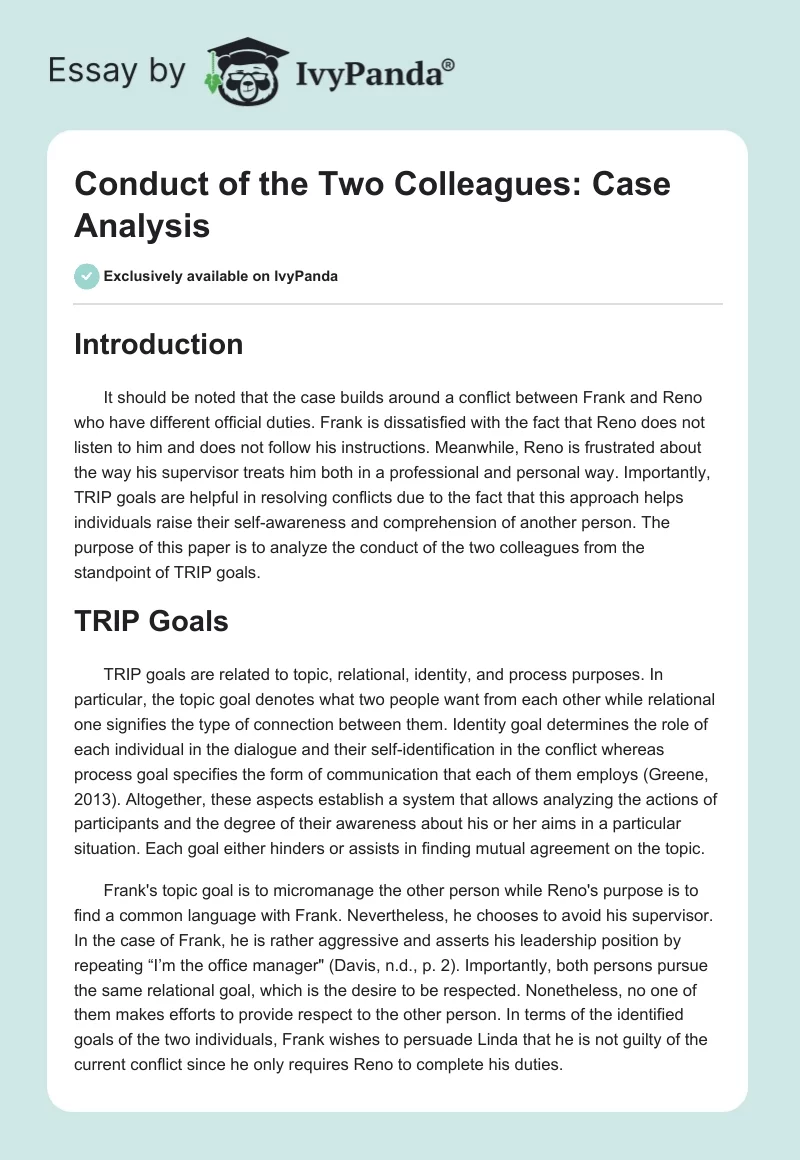Introduction
It should be noted that the case builds around a conflict between Frank and Reno who have different official duties. Frank is dissatisfied with the fact that Reno does not listen to him and does not follow his instructions. Meanwhile, Reno is frustrated about the way his supervisor treats him both in a professional and personal way. Importantly, TRIP goals are helpful in resolving conflicts due to the fact that this approach helps individuals raise their self-awareness and comprehension of another person. The purpose of this paper is to analyze the conduct of the two colleagues from the standpoint of TRIP goals.
TRIP Goals
TRIP goals are related to topic, relational, identity, and process purposes. In particular, the topic goal denotes what two people want from each other while relational one signifies the type of connection between them. Identity goal determines the role of each individual in the dialogue and their self-identification in the conflict whereas process goal specifies the form of communication that each of them employs (Greene, 2013). Altogether, these aspects establish a system that allows analyzing the actions of participants and the degree of their awareness about his or her aims in a particular situation. Each goal either hinders or assists in finding mutual agreement on the topic.
Frank’s topic goal is to micromanage the other person while Reno’s purpose is to find a common language with Frank. Nevertheless, he chooses to avoid his supervisor. In the case of Frank, he is rather aggressive and asserts his leadership position by repeating “I’m the office manager” (Davis, n.d., p. 2). Importantly, both persons pursue the same relational goal, which is the desire to be respected. Nonetheless, no one of them makes efforts to provide respect to the other person. In terms of the identified goals of the two individuals, Frank wishes to persuade Linda that he is not guilty of the current conflict since he only requires Reno to complete his duties.
It is evidenced by Frank’s statement that “Reno knows he’s supposed to do what I ask him to do” (Davis, n.d., p. 2). Therefore, Frank is trying to save his face in this conflict. Unlike Frank, Reno employs an opposing strategy and wants to express that he is the victim due to the fact that his supervisor treats him disrespectfully and does not provide the necessary instruction and guidance. Regarding process goals, neither of them comprehends the importance of communication. Both men prefer talking to a third party rather than trying to reach a joint agreement together. For instance, Frank insists that Linda talks to Reno while Reno refuses to communicate with Frank because “he seems so hostile” (Davis, n.d., p. 3).
Apart from that, the goals of the two people also change in a different manner. Despite the fact that Frank is aggressive and insists on subordination, he is willing to resolve the conflict. He asks Linda to talk to Reno to regulate the critical situation. Thus, it can be stated that from a self-defending position he switches to the goal of mitigating the misunderstanding and miscommunication (Davis, n.d.). Reno, in his turn, sticks to his position of a victim in this conflict and gradually shifts to avoidance. Notably, he recognizes the presence of a conflict at a critical stage; nonetheless, he prefers ignoring the advice to talk to Frank face-to-face assuming that it will only make the situation worse. Therefore, the evolution of goals does not contribute to the improvement of the setting since neither of the two people is eager to work jointly on establishing a more positive work environment.
Concluding Points
Thus, it can be concluded that the conflict between Frank and Reno is far from being resolved. Importantly, communication is one of the essential aspects of daily interaction, and if it does not contribute to reaching an understanding between people, it is rather likely that a conflict will appear. Unfortunately, neither Frank nor Reno were able to communicate their ideas to each other; therefore, no one of them understood what they wanted from each other (Greene, 2013). TRIP goals could assist greatly in resolving the conflict between these two people. If each of them analyzed the topic of their communication and concentrated on what they wanted to achieve, it would be easier for them to reach an agreement by making choices that are more rational. In addition, if the colleagues treated others the way they wanted to be treated themselves, the issue of being disrespectful would have never appeared.
References
Davis, D. (n.d.). Half empty/half full [PDF document].
Greene, J. (Ed.). (2013). Message production. New York, NY: Routledge.


